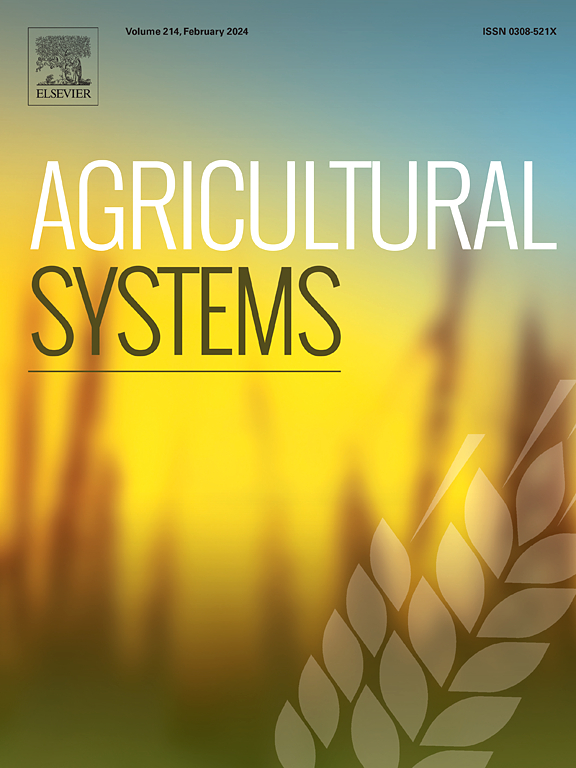在有机农场与奶牛的食物供应,土地利用动态和饲料食品竞争的定位分析
IF 6.1
1区 农林科学
Q1 AGRICULTURE, MULTIDISCIPLINARY
引用次数: 0
摘要
对土地日益激烈的竞争要求对土地利用效率有新的看法。当科学家和政策制定者把重点放在减少环境危害的粮食安全问题上时,必须讨论优先次序。如果考虑到农场用途和使用的土地类型,与以植物为基础的生产相比,一些奶牛农场可能并不像人们普遍认为的那样是资源低效的。本研究旨在通过对有奶牛的有机农场的定位分析,提供关于农业土地利用效率的细微差别和经常被忽视的观点及其评估方式。它考虑了景观特征、农场设计、土地利用、粮食产出、天气条件以及农民的考虑和动机,以产生与环境相关的土地利用见解。方法利用4个有机案例农场的详细数据,量化农场门口的土地利用总量和粮食产量,并通过土地利用比(LUR)估算基于土地的饲料-食品竞争。在保持有机视角的同时,利用LUR将同一地区目前的动物性或混合生产产出与潜在的植物性食品产出进行比较。定量结果通过农民的见解和多个农场访问的观察得到验证。所分析的农场的特征是A)边际土壤上的乳制品生产,B)再生草基乳制品生产,C)饲料-无食物混合畜禽-作物系统,D)作物生产的高产奶牛场。结果与结论研究结果表明,与高产乳制品生产(D)相比,主要依靠不适合粮食作物种植的土地(a)支持的饲料-无食物混合畜禽-作物生产(C)或乳制品生产(a)可以获得同等或更高的土地利用效率,并具有更低的饲料-食品竞争。关于效率的结论受到测量单位、关于健康农业生态系统构成的基本假设以及年份之间的波动的强烈影响。得出结论最重要的是已使用土地的特征、经评估适合耕种的土地利用份额以及估计替代纯植物来源粮食生产的假设产量。通过定位和混合方法的视角,我们进一步展示了其他关系,如养分流动、自然护理、景观开发和农民的考虑是如何相关的。将定量估计与关于农民及其景观的定性知识相结合,将在类似研究中经常被忽视的关系纳入分析,并为讨论奶牛在未来粮食生产系统中的相关性提供了细致入微的基础。本文章由计算机程序翻译,如有差异,请以英文原文为准。

Situated analysis of food supply, land-use dynamics, and feed-food competition at organic farms with dairy cattle
CONTEXT
The increasing competition for land calls for new perspectives on land-use efficiency. Prioritisation must be discussed, as scientists and policymakers focus on food security with reduced environmental harm. Some farms with dairy cattle may not be resource-inefficient when compared to plant-based production, as generally believed, if the farm purpose and type(s) of land used are considered.
OBJECTIVE
This study aims to provide nuanced and often ignored perspectives on agricultural land-use efficiency and the ways this is assessed, through situated analysis of organic farms with dairy cattle. It considers landscape characteristics, farm designs, land uses, food outputs, weather conditions, and farmer considerations and motivations, to produce context-dependent land-use insights.
METHODS
Using detailed data from four organic case-farms, we quantified the total land use and food output at the farm gate and estimated the land-based feed-food competition through a land-use ratio (LUR). The LUR was used to compare current animal-based or mixed production outputs to potential plant-based food outputs from the same area, while maintaining an organic perspective. The quantitative results were qualified by insights from farmers and observations from multiple farm visits. The characteristics of the analysed farms were A) dairy production on marginal soils, B) regenerative grass-based dairy production, C) feed-no-food mixed livestock-crop system, and D) high-yielding dairy farm with crop production.
RESULTS AND CONCLUSIONS
The results showed how a feed-no-food mixed livestock-crop production (C) or dairy production primarily supported by land unsuited for food crop cultivation (A) can be as or more land-use efficient and have lower feed-food competition than a high yielding dairy production (D). The conclusions on efficiency were strongly influenced by the measuring unit, underlying assumptions on what constitutes a healthy agro-ecosystem as well as the fluctuations between years. Most important for the conclusion was the characteristics of the used land, the share of land use assessed suitable for cultivation, and the assumed yields for the estimated alternative pure plant-sourced food productions. Through the situated and mixed method perspectives, we furthermore showed how other relations such as flows of nutrients, nature-care, landscape development and farmers' considerations are relevant.
SIGNIFICANCE
Combining quantitative estimations with qualitative knowledge about farmers and their landscapes bring relations that are often ignored from similar studies into the analyses and provides a nuanced basis for discussion of the relevance of dairy cattle in future food production systems.
求助全文
通过发布文献求助,成功后即可免费获取论文全文。
去求助
来源期刊

Agricultural Systems
农林科学-农业综合
CiteScore
13.30
自引率
7.60%
发文量
174
审稿时长
30 days
期刊介绍:
Agricultural Systems is an international journal that deals with interactions - among the components of agricultural systems, among hierarchical levels of agricultural systems, between agricultural and other land use systems, and between agricultural systems and their natural, social and economic environments.
The scope includes the development and application of systems analysis methodologies in the following areas:
Systems approaches in the sustainable intensification of agriculture; pathways for sustainable intensification; crop-livestock integration; farm-level resource allocation; quantification of benefits and trade-offs at farm to landscape levels; integrative, participatory and dynamic modelling approaches for qualitative and quantitative assessments of agricultural systems and decision making;
The interactions between agricultural and non-agricultural landscapes; the multiple services of agricultural systems; food security and the environment;
Global change and adaptation science; transformational adaptations as driven by changes in climate, policy, values and attitudes influencing the design of farming systems;
Development and application of farming systems design tools and methods for impact, scenario and case study analysis; managing the complexities of dynamic agricultural systems; innovation systems and multi stakeholder arrangements that support or promote change and (or) inform policy decisions.
 求助内容:
求助内容: 应助结果提醒方式:
应助结果提醒方式:


